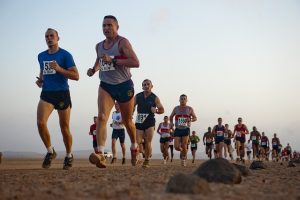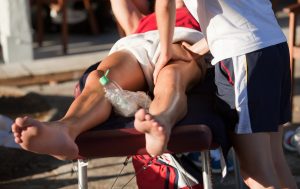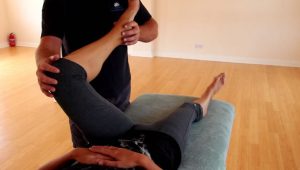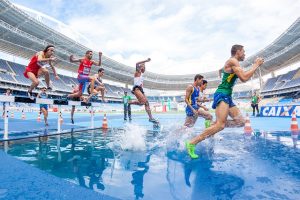With the increasing interest in physical fitness, personal training, eating well and well-being, there is now, more than ever, a need for Sports Massage Therapists. We are delighted to be teaching a pioneering combined ITEC/VTCT Level 3 and 4 Sports Massage at our convenient and beautiful venues in Brighton and Bath and we are also thrilled to be including the Diploma in Structural Rebalancing, as part of this qualification. This is the ultimate combined qualification!
What is Sports Massage?
Sports massage was originally designed for athletes to help prevent them from developing injuries related to repetitive and strenuous exercise and activity, and also to relieve pain and any injuries that they may already be experiencing.
However, it is now considered that Sports massage can be highly beneficial physically and psychologically for many people, whether active or not. Sports massage can be used for people that are physically active and involved in sports but can also cater to different types of clients with mixed lifestyles and activity levels as it can be beneficial for those with chronic pain or injury too.
Definition of Sports Massage:
Sports massage is a “hands-on” treatment that involves massage and manipulation of the muscles and soft tissues, working on the musculoskeletal system, using varied and differing techniques for enhanced efficiency. Soft tissue is the connective tissue that has not hardened into bone or cartilage, for example, the skin, the muscles, the tendons, ligaments and fascia.
Sports massage focuses on reducing tension in the muscles, increasing the elasticity of the soft tissues and generally enhancing circulation. It can also be helpful in relieving tight muscles.
Sports massage has been developed to correct issues, imbalances and problems in the soft tissues that are caused by repetitive and demanding physical activity and injury or trauma.
Sports massage is frequently used before and after exercise, as it is considered to enhance performance, help the recovery process and prevent/minimise injury.
Sports massage techniques include the more well-known massage techniques including effleurage, wringing, kneading, friction, hacking, vibrations and also some trigger point releasing. These techniques and movements are used to improve recovery after exercise, increase overall range of motion and flexibility, reduce and release muscle pain, mobilise the soft tissues, improve blood circulation and reduce lactic acid build-up, to name but a few.
When working with athletes, these techniques are all designed to help them achieve maximum performance and physical conditioning alongside decreasing their chance of injury and pain and aiding an improved recovery period. When working with people that perform sports, the massage is systematic and focused, targeting muscles that are used in that particular sports modality.
A fully trained and qualified Sports Massage Therapist can support clients with their training, achievements and goal-setting. It’s important to have a good dialogue with your Sports Massage Therapist so they know what a client is hoping to achieve and help to manage their expectations for their treatments.
Sports Massage Professional Training Course:
We are delighted to be teaching a pioneering combined ITEC/VTCT Level 3 and 4 Sports Massage at our convenient and beautiful venue in Brighton and we are also thrilled to be including the Diploma in Structural Rebalancing, as part of this qualification. This is the ultimate combined qualification!
Structural Rebalancing techniques are all sports massage related and much more so integrate fantastically well as part of the sports massage qualification. Structural Rebalancing is a style of bodywork which has been influenced by a more holistic and creative approach to sports and remedial massage developed by Michael Gibbons during his 30 years as a bodywork therapist.
This combined qualification will help train you to be more creative in your application of Sports Massage and will help you understand the fundamentals of working with deep and subtle massage techniques. You will be trained to an exceptionally high standard in the delivery of Sports Massage techniques in this popular and desirable vocational qualification. You will also enjoy huge job satisfaction by working with clients with your expert skills and Sports Massage techniques.
These skills will dramatically enhance your Massage Practice and open a whole new world of techniques that will enable you to achieve amazing results in the treatment room.
What is Structural Rebalancing?
Fundamentally, Structural Balance in the body is a simple idea based on a holistic approach to bodywork. You will learn to work with the body as a complete system. Supporting the whole without getting lost in chasing symptoms around and around! Structural Rebalancing allows the body to heal itself in the right conditions. You will learn how to create these conditions.
Michael Gibbons, College Principal at the College of Classical Massage, established in 1999, has devised this new, unique and pioneering course inspired and influenced by his extensive multi-disciplinary approach. In creating ‘Structural Rebalancing’ Michael has taken inspiration and cherry-picked the best and most effective techniques from his extensive years of thorough bodywork training including: his 4-year training as a McTimoney Therapist, training in Sports and Remedial Massage, Deep Tissue, Onsite, Aromatherapy, Thai Yoga Massage and Biodynamic Cranio-Sacral Therapy.
“I strongly believe that any experienced body-worker can integrate this bodywork into their practice and get real results without having to take each of these as individual, time-consuming and expensive courses.”
What are the benefits of Sports Massage?
One very popular aspect of sports massage is the pre and post-exercise treatment. For pre-training, the treatment may be focussed on warming up the body and especially the muscles or performing a pre-workout stretch or mobilisation. For post-workout treatment, the massage may be more geared towards reducing soreness, increasing flexibility and mobilising the joints and tissues and relaxing the tired muscles, thereby improving lactic acid reduction. If there is a specific event that the client is working towards, the pre-event sports massage session would generally be planned for approximately 24 hours or so before the occasion. The session would be fairly light and stimulating, directing the focus towards the areas that are likely to be worked hard during the event.
Once the event has passed, the Sports massage session will be more focused on helping your body to return to normal as comfortably and speedily as possible. This will generally be planned for 24-48 hours post-event. It will be aimed at reducing recovery time, preventing muscle soreness, relaxing the muscles, and reducing any discomfort or soreness
Sports massage techniques are very varied and can involve stretching and fast-paced, invigorating massage depending on desired outcomes, what activities the client is partaking in or whether it is for injury and pain, and dependent on what parts of the body need work.
When working with dedicated and more professional sports clients and athletes, they can require sports massage applications between their training sessions to reduce their risk of injury and to improve their recovery time. These ongoing treatments can be very important to address any continuing injuries, decreasing muscle tightness with the aim of reducing and hopefully preventing any new injuries or issues.
If you have clients that already have sporting injuries, then sports massage treatment can be great for addressing acute or chronic problems and issues. This type of sports massage is known as rehabilitative and works to break down any scar tissue, alleviate pain, reduce inflammation, and relieve muscle tension with a view to improving flexibility and mobility. The aim is to also reduce the possibility of re-injury.
Fully qualified Sports Massage Therapists are also trained to assess areas of tightness and tension, which when treated can help prevent injuries from occurring by rebalancing, relaxing, and invigorating these areas.
Sports massage is commonly considered to be useful for clients that exercise in moderation and intensely.
However, there are many other reasons you would consider offering this therapy to your clients. These include:
- Pain relief – massage is frequently used to reduce the feeling of pain, as by working on the muscles, and encouraging relaxation of these muscles, massage can encourage the pain-relieving hormones, known as endorphins. These endorphins can help improve pain relief, and mood and generally support a client’s mental, emotional, and physical health and well-being.
- Promote a feeling of relaxation – working on the muscles and potentially relieving areas of pain, encourages relaxation which can boost your feelings of relaxation.
- Anxiety reduction – by promoting relaxation, in turn, can promote a better mood and reduced anxiety and stress levels.
- Promoting energy levels – for some clients the techniques of sports massage can be quite invigorating which can boost energy levels and motivation.
- Improved flexibility and mobility – By working on the muscle groups, promoting relaxation and a reduction of tension in these muscles, this can promote flexibility and better mobility in the whole body, including the various joints.
- Increased blood flow – by working on the muscles, it enhances the circulation of blood to the different muscle groups. This has many beneficial effects.
- Avoiding or delaying DOMS (delayed onset of muscle soreness) – sports massage is frequently considered to help prevent or bypass DOMS, by working on boosting the blood flow to the muscles through massage, which in turn delivers more oxygen to these areas that have been worked through exercise. It is considered that DOMS occurs due to metabolic insufficiency that comes on when the blood supply cannot meet the body’s demand for oxygen, which in turn leads to the formation of lactic acid. Injury prevention – by working on the muscles pre and post-workouts, this is considered an important factor in preventing injuries in the muscles and joints. Sports massage aims to reduce muscle tension which can lead to joint stress and injury, and it also promotes more muscle balance and alleviating muscle tension which is all working towards injury prevention.
- Break down of scar tissue – any previous injuries that a client has sustained may have scar tissue remaining. It is considered that massage has the potential to soften and break down scar tissue which in turn should result in a decrease in possibility of further injury to that area.
- Recover post-workout – although sports massages vary, one commonality is considered to be it’s ability to restore the body to it’s optimal position and balance post-exercise and post-injury. These treatments can enhance the healing process with their ability to increase blood supply and oxygen to any injured or sore area.
- Promote removal of toxins – one of the major benefits of sports massage is considered to be its ability to reduce the build-up of toxins in the body which when built-up can reduce someone’s physical ability and daily mobility. Sports massage is thought to help significantly with this.
Frequently Asked Questions:
Which should I train in, Sports Massage or Body Massage?
In short:
Body Massage is a massage that you learn which is designed to offer relaxation predominantly for the whole body. The routines and techniques can be adapted towards certain parts of the body to reflect your client’s needs and preferences but in training in Body Massage, you will learn relaxation and therapeutic massage techniques for the whole body.
Sports Massage is more intended and focused towards clients that perform Sports in some capacity – moderately or intensively, to support them with their training and performance and to work on injury prevention and injury recovery. The massage techniques learnt tend to be more aimed at working on a particular part of the body dependent on the client’s needs.
We are teaching our fantastic Level 3 & 4 Sports Massage combined with our pioneering and unique Diploma in Structural Rebalancing from our Brighton venue from October 2023. Check out the details here.
Sports Massage Vs Deep Tissue – Whats the difference?
Frequently asked questions:?
The short answer is: Deep Tissue Massage can be really helpful for clients that are experiencing general whole-body pain that can be caused by stress and tension. Clients may want to experience more ease of movement and reduction in tension that can be caused by stress-induced pain and muscle adhesion.
Sports Massage is more designed for active clients that are looking for specific treatment for injuries and repetitive sprains and strains, improved performance in their particular sporting activity, improved recovery from activity and injury prevention. It tends to be more of a specific body part, targeted approach than a whole body application.
The longer answer is:
Sports Massage tends to offer wide-ranging techniques that are designed to realign and loosen muscle fibres for active clients that want support to improve their performance in their given field of sports training and who might have sports-related tension. They may request pre- and post-workout sports massage application. They may be needing support for injuries and pain, or injury prevention. Sports Massage can also aid recovery from Sporting activities and events. Often sports massage is a more targeted approach for certain parts of the body, for example, the legs for runners or the arms and shoulders for tennis players. Sports massage often incorporates soft tissue release techniques (STR) to work on tension and adhesions within the muscle fibres and soft tissues. Proprioception neuromuscular facilitation (PNF) and Muscle energy techniques (MET) to help stretch tight muscles and provide motor stimulation to muscles that may be weaker and not firing as effectively. Deep tissue techniques are also learnt and applied during a Sports massage session.
Deep tissue massage is often administered by a body massage therapist or a sports massage therapist, with pressure being applied to the soft tissues of the body. Depending on the desired outcome the pressure can be applied at increasing levels until the desired outcome is reached. Some pressure can be quite light but still have an effect on the deeper soft tissues. While some pressures can be a lot firmer and require a focus on a releasing breath to help release the tension/discomfort in different areas of the body.
Deep Tissue Massage techniques are generally learnt by Body Massage Therapists, who learn some additional applications after their initial professional massage diploma training. These can then be applied to the whole body or certain areas with the intention of: relieving pain, inducing a deeply relaxing state, promoting blood flow, reducing stress, easing out knots in the muscles, reducing muscle stiffness and stagnation. These are offered to clients that exercise regularly or not. Often, deep tissue massage is offered as a whole body treatment but with firmer pressure than a general relaxing body massage.
A deep tissue massage will incorporate sustained firmer pressure using slower and deeper strokes, often by using the elbows, fists and reinforced thumb methods, which target the deeper levels of muscles and connective tissue. This encourages improved blood flow to the areas being worked which in turn loosens tight muscles and knots, the aim is to release tension and tightness held deeply in the muscles and tissues. This is why it is great for targeting generalised muscle pain and stiffness. This also makes it fantastic for general relaxation, stress relief and mental and physical well-being.
Benefits of Deep Tissue Massage:
Some clients prefer deep tissue massage for its many benefits which may include:
- General muscle relaxation
- Reduced pain levels
- Greater mobility in areas which are often tight and lacking in movement.
- Lower stress levels
- A decrease in tension is experienced frequently in the upper back, shoulders and neck.
- Deep tissue massage frequently reduces muscle tension and associated discomfort and pain in the lower back region.
Check out our YouTube channel for many Deep Tissue Massage videos





